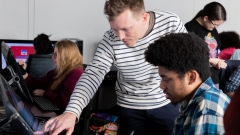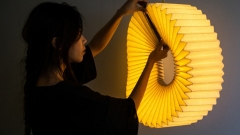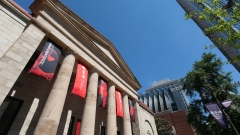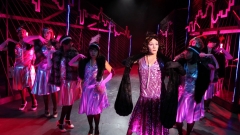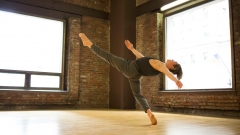Visionary Creative Interchange—An Unusual Collaboration
by David Yager
<< back to President's Speeches & Messages
Featured in the March 5, 2018 issue of Brooklyn Rail
I trained as a designer and fine-arts photographer, which are disciplines based on observation. Photography and research took me into the gallery space, the academy, the technology industry, and to one of the leading medical centers in the world. My creative instincts led me to found the Innovation and Design Lab (IDL) at the University of Maryland Baltimore County and the University of California, Santa Cruz in partnership with the Johns Hopkins Children’s Center (JHCC).
Regardless of the field, how often are new ideas dismissed under the premise that “we’ve always done it this way?” We may be up against the misconception that innovative or non-traditional approaches will be cumbersome, misaligned, and impersonal. My work at the JHCC set out to prove the exact opposite—by using technologies creatively, we set patients’ and their families’ needs as top priority while maintaining or improving upon health outcomes.
The interplay between my non-linear way of thinking and the successful medical protocols developed and tested at an institution as revered as Johns Hopkins turned out to be a winning blend. I credit Dr. George Dover, former Director of the Department of Pediatrics at JHCC. His leadership, vision, willingness to collaborate and to hear from an artist’s/designer’s perspective was embraced without hesitation. What began as a tightly-budgeted time slot to meet George Dover for the first time turned into a multi-hour, post-9:00 p.m. departure at which point we had become enthusiastic colleagues and friends committed to improving the safety, operations, and health outcomes of children treated at JHCC.Often, my meetings with Dr. Dover were the highlights of my week, and I was always touched each time he admitted the same.
Faculty, leaders, administrators, and staff at the Children’s Center took risks and embraced change in order to achieve new goals. My IDL group leveraged creativity and innovation, asked new questions, set new goals, built prototypes, and tested hypotheses. The diversity of thinking also included a few “Daniel Boones,” pioneers who pushed boundaries to solve problems. By contrast, my questions had the deadpan honesty of Forrest Gump, and, metaphorically, we worked like a piece of sand in an oyster turning it into a pearl. I think part of George Dover’s support was derived from the pure joy of watching that paradox unfold for each IDL project. He was not only helpful in bringing a diverse group of medical minds together, he also opened up dialogues with the Daniel Boones of the institution who took to our collaborations as opportunities to think differently—sometimes for the first time.
One of our IDL research projects was for digital anesthesia, which is the application of virtual reality (VR) technology and content to reduce pain with digital technology instead of pharmaceuticals. This is a particularly attractive option for pediatric patients who are, ironically, less sensitive to certain pain medications than adults. We observed children with Ataxia-telangiectasia (A-T), which is a rare, progressively degenerative disease that involves degradation of muscle control leading ultimately to being confined to a wheelchair. We observed A-T patients, noting their level of concentration was especially strong playing video games but paradoxically challenged with “ordinary” tasks, like holding a glass of water. What would happen if A-T patients could undergo difficult medical procedures while immersed in a VR experience? During earlier projects, the IDL team realized the importance of continuous digital body monitoring for vital and clinical signs and symptoms to help control levels of pain while using VR as a key distraction. Using VR, it was possible to intervene in the cycle of pain. We monitored the patient’s heart rate, body temperature and pulse, triggering VR content at just the right time to prevent pain from escalating to levels requiring significantly more pharmaceutical intervention. Would such a technology be developed and/or applied without a creative collaboration of artists/designers and scientists? Perhaps, but I question if the solution would be as inclusive (given the wide array of roles and minds brought together), holistic (given the diversity of thinking), integrated into practice (given an environment open to change), and solely to benefit patients (in a non-profit, research-driven endeavor).
I still work in the academy, but now I am President of the University of the Arts. Management is hard, change is harder, and trying to be creative in the process can feel impossible. I’m fortunate to collaborate with a diverse network of creative minds in the form of dancers, visual artists, designers, musicians, performers, and creative thinkers in liberal arts who help me think about the future, and challenge some of the past.
In this position I have often had the opportunity to ask myself: can you teach creativity and innovation? The answer is “yes.” We do it in the classroom, but we also do it outside the classroom, in a collaborative, real environment.

